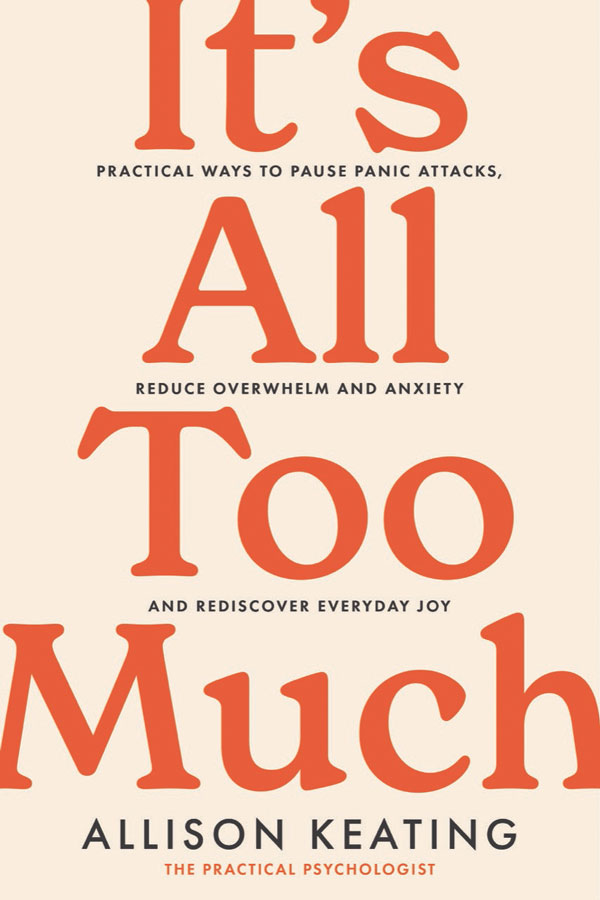Just like that, the leaves are changing colour and starting to fall, and our calendars become chock-a-block. Maria Neuman chats with psychologist and author Allison Keating about how to keep your mental health in-check this season …
Does it seem like autumn – and the fast-approaching holidays – have gone from the season of giving and joy, to the season of more work and obligations? While most of the animal kingdom is hunkering down for a few solid months of hibernation, we seem to have made these shorter days all about end-of-year reports, late-night shopping and menu planning (don’t even get us started on the WhatsApp groups).
“It’s not just about feeling anxious and overwhelmed, it genuinely is too much,” says Allison Keating (@thepractical.psychologist), who has operated her own practice at the bWell Clinic in Dublin County for more than 20 years, and authored the newly-released, It’s All Too Much (Gill Books, €18.99). “We are naturally wired to be a one-track species, so our brains really don’t enjoy all the multi-tasking, but it’s become part of everyday life”.

Sharing the same advice and tips she gives to her clients, who come to her for everything from panic attacks to burnout, here are 10 simple ways to feel calmer and more joyful … and how a kitchen dance party is scientifically proven to work wonders!
1) Make a genuine connection: When you bump into someone and they ask how you’re doing, don’t fall into the old “I’m fine” line. Instead, try being honest if you’re feeling overwhelmed as this creates a true connection. Keating suggests, “You could say something like, ‘I find this time of year quite stressful and it feels like a lot at the moment’”. “Women internalize their anxious thoughts and feelings, so connecting with someone else can make you feel supported and less overwhelmed.”
2) Try a daily somatic check-in: Somatic means “relating to the body as opposed to the mind”, where an emotion manifests in your body (like butterflies in your stomach). Keating suggests, at any point during the day, sitting and putting one hand on your stomach or heart, closing your eyes and asking yourself, “what do I need?” If there’s an anxious tightness in your chest, perhaps take a look at your to-do list and see if you can push something until tomorrow. “Sometimes, I’m just tired and need a cup of coffee and to stare out the window for five minutes to give myself a break,” Keating says. It’s about getting that connection back with your body.
3) Put your to-do list into Google Maps mode: “Think of where you want to go and the course of action to get there,” advises Keating. “Just like looking at directions on our phone, there is a destination that includes the steps you need to take to get there.” Breaking a task down can help it seem more manageable. This can also work for your mood: think about the steps you can take to alleviate stress, write them down and start the process.
4) Add movement to your calendar: We’ve all read the data about how moving the body can improve your mood, but it can also be the first thing we let slip when busy. “It has to be written into your calendar, like an appointment, or you won’t do it,” Keating warns. “Try a twenty minute walk first thing in the morning before everything else steals your time.” If possible, try to make ten minutes of that walk sans calls, podcasts or music – just listen to the sounds around you. “Feel the ground under your feet, look up at the trees and listen to the birds because all of this helps to regulate and calm your nervous system.”
5) Have a solo dancy party: It turns out Taylor Swift was onto something with her “Shake It Off” hit. Dancing releases chemicals into the brain that work to reduce cortisol levels (the stress hormone responsible for our “fight or flight or freeze” modes). Shaking large muscle groups like the arms or legs can act as a pressure valve to flush these out of your system. “I love upbeat dance music because the beat mimics a heartbeat, but pick whatever you like,” Keating suggests.
6) Change your inner dialogue: We are all our own worst critics. All of us have left a work meeting mortified about something we said, embarrassed by a sudden outburst, or blurted out something we regretted later. “Instead of berating yourself, challenge it with compassion and curiosity,” says Keating. “I tell my clients to think, ‘I really lost it today, that really triggered something in me, I wonder where that came from?’” This would also be a good time to implement number 2 on this list.
7) Look for little glimmers: Keating defines a glimmer as a small moment that gives you joy. Anything like noticing a beautiful sunrise or sunset, or even a pleasant exchange during the day. “These become like a physiological sigh – the more you seek them out, the more you notice them, and they help take the edge of any harshness in your day,” adds Keating. Speaking of joy, Keating prefers it to happiness, as it’s characterised as a state of being that’s long-lasting and content, as opposed to happiness, which is fleeting.
8) Learn to actively rest: Sometimes, it’s not always a nap, or putting your feet up, that’s needed. Maybe it’s doodling, going for a walk, run or bike ride, or just stopping to smell the roses. Do something you truly enjoy. As well as physical rest, there’s also emotional and social rest, and all three need to be balanced in order to feel your best.
9) Set boundaries: Who hasn’t agreed to do something they have no interest in doing? Take a holiday gathering – it’s okay to set a boundary. Simply say, “Sorry, I’m already booked,” Keating suggests. No explanation needed. If it’s something you should go to, opt instead for a, “I’d love to pop by, but I have to leave by nine.” Even with work tasks, it’s reasonable to say to a manager, “I don’t think I get can complete both projects by Friday, if I can finish one this week and the second early next week?”. Keating says the hardest part of setting a boundary is sitting with someone else’s disappointment. “We all want to keep the peace, but don’t do it at the expense of your own wellbeing,” she adds.
10) Check your perfectionism: “I see a lot of patients with high-functioning anxiety – they are killing it at work and have a seemingly perfect home life, but in their private time they can’t switch off,” warns Keating. These days, putting our best face forward has become part of our identity, but it’s not sustainable in the long-term. “If things feel too much, it’s okay to tell yourself you can’t do something to your usual standard. Instead, bring it down to ‘good enough’. That can be an uncomfortable space for a lot of women, but your nervous system will thank you.” Cue Taylor Swift!
Here are some other words of advice from Maria Neuman that might help you or a loved one this Mental Health Awareness Month.
Are You Lonely? You’re Not Alone: Ireland Is The Loneliest Place In Europe











